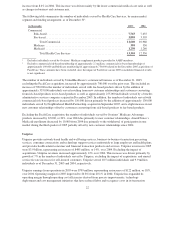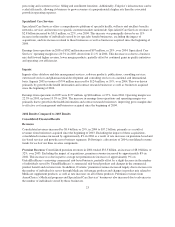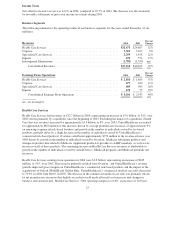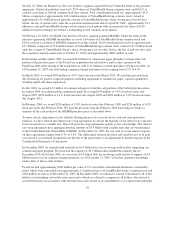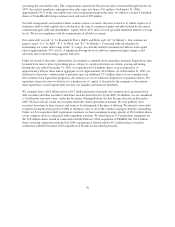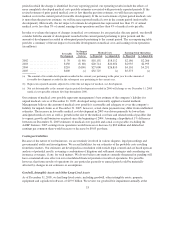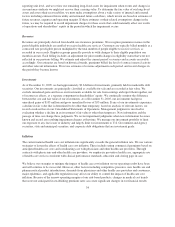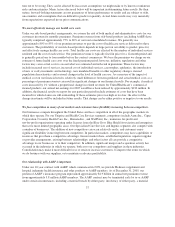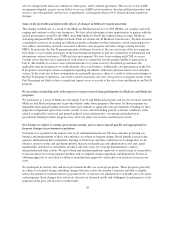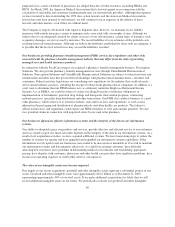United Healthcare 2005 Annual Report Download - page 34
Download and view the complete annual report
Please find page 34 of the 2005 United Healthcare annual report below. You can navigate through the pages in the report by either clicking on the pages listed below, or by using the keyword search tool below to find specific information within the annual report.Medicare Part D Pharmacy Benefits Contract
The Company has contracted with the Centers for Medicare & Medicaid Services to serve as a Prescription Drug
Plan sponsor offering Medicare Part D prescription drug insurance coverage to eligible Medicare beneficiaries,
beginning January 1, 2006. This product is either offered as a stand-alone product or as an element of the
Medicare Advantage products.
As a result of this contract and the December 2005 acquisition of PacifiCare, premium revenues from Medicare-
related programs, which have historically been approximately 10% of total premium revenues, are expected to
increase to approximately 25% in 2006.
Regulatory Capital and Dividend Restrictions
We conduct a significant portion of our operations through companies that are subject to standards established by
the National Association of Insurance Commissioners (NAIC). These standards, among other things, require
these subsidiaries to maintain specified levels of statutory capital, as defined by each state, and restrict the timing
and amount of dividends and other distributions that may be paid to their parent companies. Generally, the
amount of dividend distributions that may be paid by a regulated subsidiary, without prior approval by state
regulatory authorities, is limited based on the entity’s level of statutory net income and statutory capital and
surplus. The agencies that assess our creditworthiness also consider capital adequacy levels when establishing
our debt ratings. Consistent with our intent to maintain our senior debt ratings in the “A” range, we maintain an
aggregate statutory capital level for our regulated subsidiaries that is significantly higher than the minimum level
regulators require. As of December 31, 2005, our regulated subsidiaries had aggregate statutory capital of
approximately $6.4 billion, which is significantly more than the aggregate minimum regulatory requirements.
Critical Accounting Policies and Estimates
Critical accounting policies are those policies that require management to make the most challenging, subjective
or complex judgments, often because they must estimate the effects of matters that are inherently uncertain and
may change in subsequent periods. Critical accounting policies involve judgments and uncertainties that are
sufficiently sensitive to result in materially different results under different assumptions and conditions. We
believe our most critical accounting policies are those described below. For a detailed discussion of these and
other accounting policies, see Note 2 to the consolidated financial statements.
Medical Costs
Each reporting period, we estimate our obligations for medical care services that have been rendered on behalf of
insured consumers but for which claims have either not yet been received or processed, and for liabilities for
physician, hospital and other medical cost disputes. We develop estimates for medical care services incurred but
not reported using an actuarial process that is consistently applied, centrally controlled and automated. The
actuarial models consider factors such as time from date of service to claim receipt, claim backlogs, seasonal
variances in medical care consumption, provider contract rate changes, medical care utilization and other medical
cost trends, membership volume and demographics, benefit plan changes, and business mix changes related to
products, customers and geography. Depending on the health care provider and type of service, the typical billing
lag for services can range from two to 90 days from the date of service. Substantially all claims related to
medical care services are known and settled within nine to 12 months from the date of service. We estimate
liabilities for physician, hospital and other medical cost disputes based upon an analysis of potential outcomes,
assuming a combination of litigation and settlement strategies.
Each period, we re-examine previously established medical costs payable estimates based on actual claim
submissions and other changes in facts and circumstances. As more complete claim information becomes
available, we adjust the amount of the estimates, and include the changes in estimates in medical costs in the
32


